Projects, Mardi Gras - Daily Log
Daily Log
When we set out to explore the shipwreck, one of our crew members will be sending daily logs to inform us on what is happening at the end of each day.
21 May 2007
Update by Della Scott-Ireton, Florida Public Archaeology Network
First day of the Mardi Gras Shipwreck Project! Today has been a day of hurry up and wait as project crew gather at the research vessel, Toisa Vigilant, docked at Port Fourchon south of New Orleans. Vigilant is owned and operated by Toisa and is leased to Veolia Environmental. She is 271 feet long, complete with a helipad and giant cranes on the aft deck to hoist the Remotely Operated Vehicles (ROVs) over the side. Most of the equipment for the project (take a look at the Research Design page) has arrived and is stowed, although I understand we’re waiting for some of the positioning equipment. Best part so far is the galley, where the catering staff prepare amazing meals (also, round-the-clock ice cream).
The crew from Minerals Management Service and Texas A&M University have arrived and we’ve all gotten a safety briefing and tour of the vessel. As the Safety Officer for the vessel said, “No matter how many artifacts are recovered, if someone gets injured the project is a failure.” Safety is certainly the first concern and we’re all careful to wear hardhats, safety glasses, and steel-toed boots on deck.
Tomorrow we should arrive at the shipwreck site, about 40 miles south of the coast of Louisiana. Then we have to wait while the underwater recording equipment is deployed and calibrated before the real archaeology can start.
22 May 2007
Update by Della Scott-Ireton, FPAN, and David Ball, Minerals Management Service
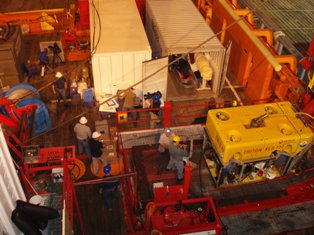
Day two and Port Fourchon is 40 miles behind us. All equipment was loaded and we left port at 9:30am, arriving on-site around 7:00 in the evening. While en route the Texas A&M conservation crew set up the on-deck conservation lab to handle the artifacts as they are brought up by the ROV. An area of the bridge called the bull pen has been set up as the center of operations with networked computers to show real-time video from the ROVs. Two archaeologists, one to coordinate artifact recovery and one to record data into the Site Recorder program, will be stationed in the bull pen. An additional archaeologist will be with the ROV pilots in their shack.
The crew shift roster was posted today: Dave and I, along with Ashley Rose Gould and Alexis Catsambis from TAMU, are on the midnight to 8am “graveyard” shift; Jack Irion, Ben Ford, Cesar Arias, and Amy Borgens are on the 8am to 4pm shift; and Chris Horrell, Laura Landry, Sam Koepnick, and John Hamilton are on the 4pm to midnight shift. Peter Hitchcock, Donny Hamilton, and Bill Bryant are “floaters,” working whenever and wherever needed. We’ll work around the clock since the site is pitch-black at 4,000 feet deep anyway and daylight or dark do not make a difference in operating the ROVs.
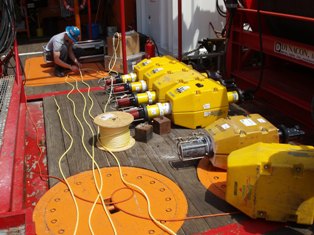 Currently it’s 2:00 in the morning as I write this and the survey crew is busy calibrating the positioning transponders, called compats. Five compats were placed on the ocean floor by the ROV earlier and will take approximately 12 hours to calibrate. The compats communicate with each other and the ROV to accurately record the position of each artifact. This careful recording is critical to understanding the lay-out of the site and the relationship of artifacts to one another. This relationship, called context, is the key to unraveling the story of the shipwreck and will help us to better understand the archaeology of the site. Ideally, we’ll begin the excavation tomorrow!
Currently it’s 2:00 in the morning as I write this and the survey crew is busy calibrating the positioning transponders, called compats. Five compats were placed on the ocean floor by the ROV earlier and will take approximately 12 hours to calibrate. The compats communicate with each other and the ROV to accurately record the position of each artifact. This careful recording is critical to understanding the lay-out of the site and the relationship of artifacts to one another. This relationship, called context, is the key to unraveling the story of the shipwreck and will help us to better understand the archaeology of the site. Ideally, we’ll begin the excavation tomorrow!
23 May 2007
Update by Della Scott-Ireton, FPAN, and Ashley Rose Gould, Texas A&M
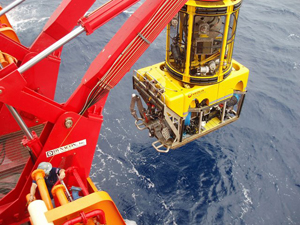
The project proceeds – the seas picked up over the last day or so which slowed us down a little, although it looks like the worst has passed and the seas are supposed to lay down now.
Today we made two passes over the site with a high resolution camera mounted on one of the ROVs, taking photographs every four seconds. The resulting photographs were stitched together to create a preliminary photomosaic of the wreck site showing all of the exposed artifacts. This photomosaic was used to decide on a plan of attack for recovering the artifacts. Large containers holding a variety of baskets and crates were prepared and lowered to the sea floor by the ROV. They are staged just off-site and are ready to hold the artifacts as they are excavated from the shipwreck. Once the containers are full, the ROV will transport the artifacts to the ship where the conservation crew will take charge of preparing them for transport to the Center for Maritime Archaeology and Conservation at Texas A&M University.
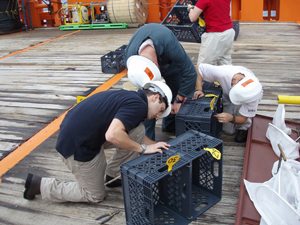 The high resolution images revealed, in addition to the artifacts we’d seen previously, several additional large concretions. These concretions are made up of iron artifacts that have corroded over long years underwater into a large mass. The artifacts within the concretion will be identified and preserved in the lab, but for now it’s difficult to tell exactly how big the concretion is, or what artifacts it might contain.
The high resolution images revealed, in addition to the artifacts we’d seen previously, several additional large concretions. These concretions are made up of iron artifacts that have corroded over long years underwater into a large mass. The artifacts within the concretion will be identified and preserved in the lab, but for now it’s difficult to tell exactly how big the concretion is, or what artifacts it might contain.
The next step is to use the positioning array, placed yesterday, to create a more detailed photomosaic. Ten passes, or lanes, will be run lengthwise across the site with the ROV about ten feet above the shipwreck and moving very slowly. Shooting four or five photos per second, this photomosaic will provide an extremely detailed site plan. Sediment and water samples will be taken to record the site’s environmental conditions, and then artifact removal can begin.
24 May 2007
Update by Della Scott-Ireton, FPAN, and Chris Horrell, MMS
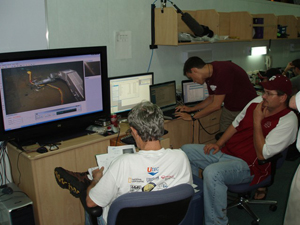
Great success today despite the weather bringing us nine-foot seas. The photomosaic photography was finished and nearly 2,000 high-resolution photographs are being stitched together to create the overall site image. Using a section of the photomosaic already finished for the stern area of the wreck, we began to recover artifacts late this afternoon. Artifacts visible at the sediment surface are the first targets and include glass bottles and ceramic plates. A small suction device, called a “sticky foot,” attached to one of the ROV’s arms is used to gently pluck the artifacts from the sediment and transport them into a basket. Each artifact is assigned a number that will follow it through the recovery, conservation, and curation process. In addition, each artifact is photographed in situ, or in place, before it is moved and its position is recorded using the acoustic compat array.  The baskets used to transport the artifacts to the surface are numbered as well so there is virtually no chance of the artifacts getting confused or lost.
The baskets used to transport the artifacts to the surface are numbered as well so there is virtually no chance of the artifacts getting confused or lost.
Because the seas are so rough, and are expected to remain rough for the next couple of days, we will place as many artifacts as possible in the baskets available and “store” them on the sea floor. Once the captain give us the OK to recover, the artifact baskets will be placed in a large lifting crate for the ride to the surface.
25 May 2007
Update by Della Scott-Ireton, FPAN, and Laura Landry, L.A. Landry & Assoc.
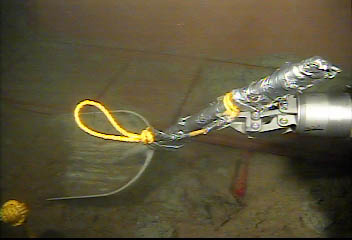
We’ve been working to compile the site photomosaic still – 2,000 photographs are a lot to process! The photos are compiled from several different data sets, including both low and hi resolution, still and video, as well as sector-scanning sonar and multi-beam bathymetry. In the meantime, the ROV has been testing specially designed tools for collecting artifacts, such as various shapes of scoops and scoop-baskets. Artifacts collected yesterday are being prepared and loaded for lifting to the surface. We are very concerned that the fragile glass bottles and ceramic plates are not broken, so are carefully layering the crates containing the artifacts, and then filling the crates with sediment from the outskirts of the shipwreck site. The sediments will “pad” the artifacts during their 4,000-foot journey to the surface, and then will be easy to remove. At that time, our conservation team will take custody of the artifacts and pad them more securely for storage and transport to the conservation lab at Texas A&M.
The ROV pilots are showing their skills! Their finesse and delicate handling of artifacts have successfully removed the selected artifacts without disturbing surrounding features. They also have mastered the use of the highly technical underwater shovel! We are using a standard snow shovel to load sediment around the artifacts in the crates.
26 May 2007
Update by Della Scott-Ireton, and Donny Hamilton, Texas A&M
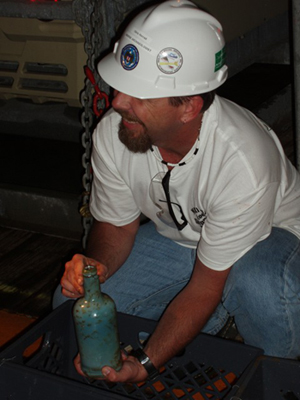
The first load of artifacts successfully made the journey to the deck of Toisa Vigilant! The captain very skillfully maneuvered the ship so the ocean swells were blocked and the lifting basket could be hauled aboard against the side of the vessel, minimizing the basket’s tendency to swing around. The sediment used to pack and pad the ceramics and bottles worked like a charm and all were undamaged. The conservation team has taken custody of the artifacts and begun the lab process.
Now that we can get a closer look at the artifacts they are even more interesting. One sandclock was recovered – the wooden endpieces are totally degraded and missing but the glass is beautifully preserved. The sandclock is one of at least six we’ve located on the site, but the first to be recovered. A large stoneware jug was discovered to have a lovely flower design etched into the side; its handle has been broken but it otherwise is in perfect condition.  The several dark green glass bottles brought to the surface probably originally contained wine and rum, and some still have their corks in place. A blue bottle is very curious – the blue coloration likely is caused by oxidation but the intense color is quite unusual.
The several dark green glass bottles brought to the surface probably originally contained wine and rum, and some still have their corks in place. A blue bottle is very curious – the blue coloration likely is caused by oxidation but the intense color is quite unusual.
A variety of creamware ceramics have been recovered, including a plate, a deep serving dish and its fitted lid with a slot for a ladle, and a desert cup called a pot de crème. The creamware seems to suggest a slightly earlier date for this shipwreck than we originally hypothesized – probably 1770 to 1790. We also are developing a better understanding of the weapons chest that is still in situ. Check out the Artifacts page for a description of what we hope to learn from the weapons, as well as a photo and drawing of the chest showing individual pieces.
27 May 2007
Update by Della Scott-Ireton, FPAN, and Kim Eslinger, Nautilus Productions

A second batch of artifacts was lifted today, which included two more sandclocks (one of which is very small), a wine bottle, and a small glass bottle with ‘LONDON’ embossed on it. This bottle is especially significant because the style gives us another clue to the date of the shipwreck. According to the Glass Glossary published by Parks Canada (1989:26-27), this type of bottle was molded in two pieces and contained mustard. The date range for these mustard bottles is 1750 to 1880, which is a large range but still includes the estimated time period for the shipwreck, and the earlier end of the range agrees with the dates of the creamware and the other bottles.
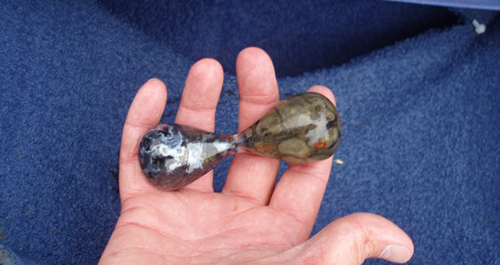 Along with the archaeological crew, the Mardi Gras Shipwreck Project also has filmmakers from Nautilus Productions. Nautilus Productions has three crew onboard, Rick Allen, Kim Eslinger, and Lawrence Taylor. Nautilus will produce a documentary on the project and the Mardi Gras Shipwreck; it likely will be shown on a major cable network next year. The documentary crew works round the clock, always ready to capture the excitement of discovery as it happens. The archaeologists have gotten used to the presence of someone with a large camera on his or her shoulder right up in the middle of everything. We’ve been interviewed at all hours, and always are careful to mind our language! Kim is also a maritime archaeologist and Larry is a marine biologist, so their expertise and insight are enormously helpful. Together with Rick’s extreme good humor, they are a delight to work with.
Along with the archaeological crew, the Mardi Gras Shipwreck Project also has filmmakers from Nautilus Productions. Nautilus Productions has three crew onboard, Rick Allen, Kim Eslinger, and Lawrence Taylor. Nautilus will produce a documentary on the project and the Mardi Gras Shipwreck; it likely will be shown on a major cable network next year. The documentary crew works round the clock, always ready to capture the excitement of discovery as it happens. The archaeologists have gotten used to the presence of someone with a large camera on his or her shoulder right up in the middle of everything. We’ve been interviewed at all hours, and always are careful to mind our language! Kim is also a maritime archaeologist and Larry is a marine biologist, so their expertise and insight are enormously helpful. Together with Rick’s extreme good humor, they are a delight to work with.
28 May 2007
Update by Della Scott-Ireton, FPAN, and Jack Irion, MMS
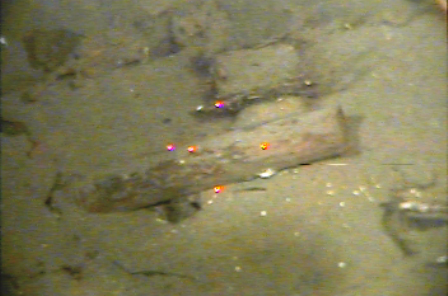
Well, today was a slow day. Early this morning we had problems with the lights on the ROV, so it had to come to the surface to be fixed. When the ROV went back in the water it got to only 200 feet before having more problems and had to be brought up again. The ROV technicians worked continuously to get it in shape, but it was several hours before it was ready to deploy again. Since we resumed work, however, we’ve cleared around the large stern concretion, which revealed a scatter of small-caliber lead shot. Several of the shot were recovered for analysis, together with a few gunflints for flintlock weapons which were among the shot.
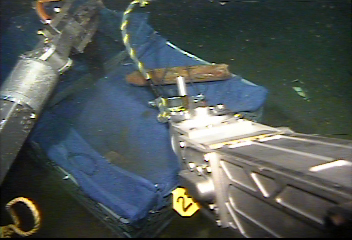 The next order of business was to recover the compasses. Two compasses complete with gimbals are near the stern concretion. While using a small ROV-mounted dredge to remove sediment from around the starboard compass we decided that the ROV was too close to the telescope for comfort, so we diverted to pick up the telescope. A little tool like a rake was used to slide under the telescope, gently lift it free of the sediment, and move it to a padded crate for lifting. We’re especially excited to inspect the telescope because it appears to still have its lenses in place. Moving back to the compass, we decided to use a modified fryer basket with the sides cut off to “scoop” it up without damaging any of its parts. This recovery is happening right now. Stand by!
The next order of business was to recover the compasses. Two compasses complete with gimbals are near the stern concretion. While using a small ROV-mounted dredge to remove sediment from around the starboard compass we decided that the ROV was too close to the telescope for comfort, so we diverted to pick up the telescope. A little tool like a rake was used to slide under the telescope, gently lift it free of the sediment, and move it to a padded crate for lifting. We’re especially excited to inspect the telescope because it appears to still have its lenses in place. Moving back to the compass, we decided to use a modified fryer basket with the sides cut off to “scoop” it up without damaging any of its parts. This recovery is happening right now. Stand by!
29 May 2007
Update by Della Scott-Ireton, FPAN, and Sam “Sparky” Koepnick, Texas A&M
The telescope came up early this morning in perfect condition. The outer casing is wood, with brass edges on the collapsing sections. The glass is in place and, though clouded, doesn’t appear to be cracked. We’re hoping we may find inscriptions on the brass edges once the scope is cleaned and conserved in the lab. We haven’t brought up the compasses yet, although the fryer basket scoop worked well to lift them from the sediment. The boat crew helped make special padded crates to hold the compasses, but the seas have picked up again so we’ll wait for a window of calm weather to bring them up.
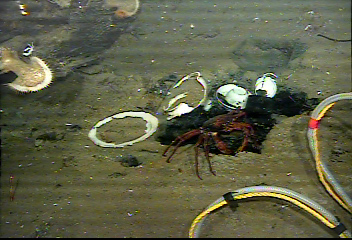 As we began to recover a broken ceramic tureen from near the weapons chest, we discovered several more intact pieces adjacent to it, including a plate, stacked saucers, a cup, and a bowl (guarded by a huge red crab in the photo). We are now in the process of using the ROV’s sticky foot to pick up these pieces and stow them in crates. As each artifact from the shipwreck is recovered, its location, or provenience, is entered into a program called Site Recorder 4, created by 3H Consulting of Plymouth, UK, especially for shipwreck excavations. Site Recorder is a program designed for keeping track of a site’s geography and artifacts and contains all information pertaining to each artifact, such as position, type, material, description, and excavator. We also keep track of the artifacts with a relational database designed in Microsoft Access® to be able to query our data set, print out reports, and keep our conservation forms in order. As the artifacts are removed from their context, the change is noted on the site photomosaic, so project staff always know how the site is changing and what artifacts remain.
As we began to recover a broken ceramic tureen from near the weapons chest, we discovered several more intact pieces adjacent to it, including a plate, stacked saucers, a cup, and a bowl (guarded by a huge red crab in the photo). We are now in the process of using the ROV’s sticky foot to pick up these pieces and stow them in crates. As each artifact from the shipwreck is recovered, its location, or provenience, is entered into a program called Site Recorder 4, created by 3H Consulting of Plymouth, UK, especially for shipwreck excavations. Site Recorder is a program designed for keeping track of a site’s geography and artifacts and contains all information pertaining to each artifact, such as position, type, material, description, and excavator. We also keep track of the artifacts with a relational database designed in Microsoft Access® to be able to query our data set, print out reports, and keep our conservation forms in order. As the artifacts are removed from their context, the change is noted on the site photomosaic, so project staff always know how the site is changing and what artifacts remain.
30 May 2007
Update by Della Scott-Ireton, FPAN, and Larry Reid, Veolia
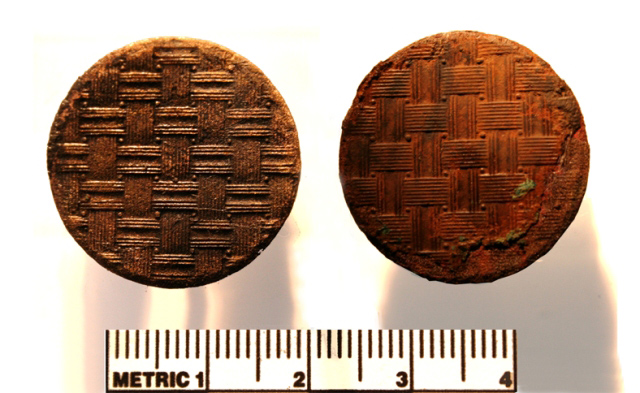 A couple of small but exciting artifacts were recovered today. Two copper alloy buttons have a basketweave design on the front; the backs feature a wreath decoration with what appears to be a crown motif. One may have stamped or engraved writing as well, although corrosion makes it difficult to tell – we’ll learn more after they are cleaned in the lab. We also found the face of a pocketwatch with hour and second numbers; a curious concretion found nearby may contain the inner workings of the clock. Most of the small artifacts have been removed and it’s nearly time to move on to the large items such as the weapons chest, stove, and cannon. We’re currently removing sediment from around the weapons chest to see how best to recover it.
A couple of small but exciting artifacts were recovered today. Two copper alloy buttons have a basketweave design on the front; the backs feature a wreath decoration with what appears to be a crown motif. One may have stamped or engraved writing as well, although corrosion makes it difficult to tell – we’ll learn more after they are cleaned in the lab. We also found the face of a pocketwatch with hour and second numbers; a curious concretion found nearby may contain the inner workings of the clock. Most of the small artifacts have been removed and it’s nearly time to move on to the large items such as the weapons chest, stove, and cannon. We’re currently removing sediment from around the weapons chest to see how best to recover it.
 All of these tiny, fragile artifacts were excavated and recovered from the sea floor by the team of ROV pilots on the project. Although under the direction of the archaeological staff, the ROV guys are the ones actually doing the work. And they are doing it with a finesse and delicacy you wouldn’t believe capable of the big robotic grasping arms of the ROV. Operating an ROV is not easy – the two-person team works together, one flying the machine and operating the 5-function manipulator, and the other person operating the complicated 7-function manipulator. They have to be aware of the large site features so they don’t bump into them, while paying close attention to the sea floor to avoid damaging fragile wooden elements of the shipwreck. All of the archaeologists are amazed at the skill of the pilots/technicians, both in operating and in maintaining and devising tools for the ROV. The pilots are very much members of the project team – they are interested in the project and in learning archaeology, and freely offer their expertise for the excavation and recovery strategy. Further, they have been good sports in using unusual tools, quickly adapting their skills to shovels, fryer baskets, and pool nets!
All of these tiny, fragile artifacts were excavated and recovered from the sea floor by the team of ROV pilots on the project. Although under the direction of the archaeological staff, the ROV guys are the ones actually doing the work. And they are doing it with a finesse and delicacy you wouldn’t believe capable of the big robotic grasping arms of the ROV. Operating an ROV is not easy – the two-person team works together, one flying the machine and operating the 5-function manipulator, and the other person operating the complicated 7-function manipulator. They have to be aware of the large site features so they don’t bump into them, while paying close attention to the sea floor to avoid damaging fragile wooden elements of the shipwreck. All of the archaeologists are amazed at the skill of the pilots/technicians, both in operating and in maintaining and devising tools for the ROV. The pilots are very much members of the project team – they are interested in the project and in learning archaeology, and freely offer their expertise for the excavation and recovery strategy. Further, they have been good sports in using unusual tools, quickly adapting their skills to shovels, fryer baskets, and pool nets!
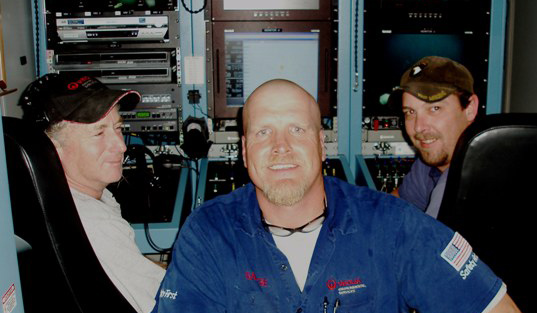 The Mardi Gras Shipwreck Project elite ROV team includes: Alan Cooper, Shane Hooyman, Dave Cruz, Henry “Hank” Lang, Joe Foster, Rob “Sarge” Longacre, Romar “Goose” Gutierrez, John Parker, John Harris, Claudio Pennelupi, Greg “Grog” Henniger, Mike “Mert” Stevens, Larry Reid
The Mardi Gras Shipwreck Project elite ROV team includes: Alan Cooper, Shane Hooyman, Dave Cruz, Henry “Hank” Lang, Joe Foster, Rob “Sarge” Longacre, Romar “Goose” Gutierrez, John Parker, John Harris, Claudio Pennelupi, Greg “Grog” Henniger, Mike “Mert” Stevens, Larry Reid
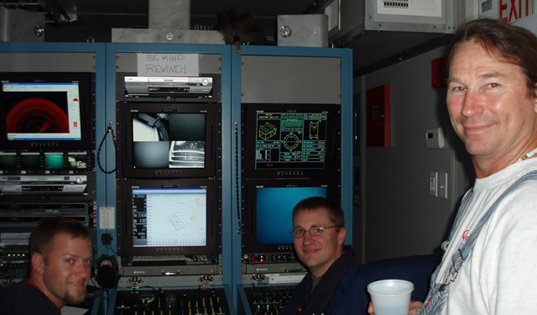
31 May 2007
Update by Della Scott-Ireton, FPAN
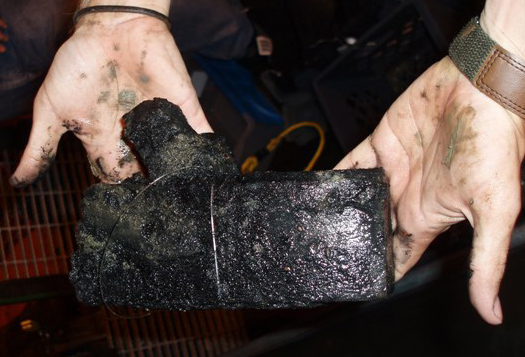 The large red lift basket was brought to the surface today containing a variety of artifacts. The two compasses, recovered Monday, safely made the trip to the surface in their padded box. They appear to be in fair condition with some glass in place, the gimbals, and the remains of at least one card (where the directional markings, or compass rose, were printed). A stoneware jug, bigger than the one previously discovered, was found to have the numeral “4” inscribed on the side, possibly referring to the capacity; several large sea anemones are growing on its neck. Yet another small sandclock came up, as well as most of the ceramics from the feature excavated Tuesday. One of the most interesting artifacts brought up today is a wooden carpenter’s plane.
The large red lift basket was brought to the surface today containing a variety of artifacts. The two compasses, recovered Monday, safely made the trip to the surface in their padded box. They appear to be in fair condition with some glass in place, the gimbals, and the remains of at least one card (where the directional markings, or compass rose, were printed). A stoneware jug, bigger than the one previously discovered, was found to have the numeral “4” inscribed on the side, possibly referring to the capacity; several large sea anemones are growing on its neck. Yet another small sandclock came up, as well as most of the ceramics from the feature excavated Tuesday. One of the most interesting artifacts brought up today is a wooden carpenter’s plane.
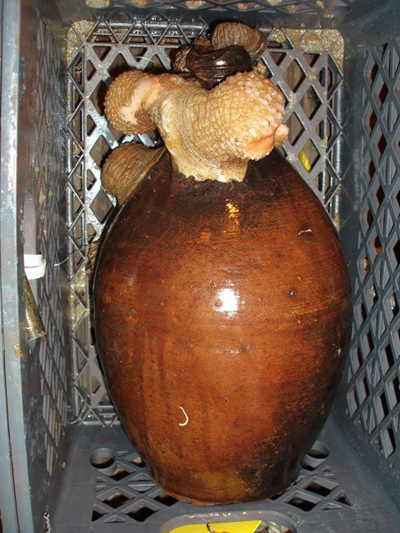 Having recovered all of the small artifacts from the surface of the wrecksite, the next step is to raise the large artifacts. The ROV crew currently is rigging lifting straps around the cannon in preparation for retrieval. The plan is to secure the cannon with the straps, then use Toisa Vigilant’s large deck winch to lift all the way to the deck. Following the cannon, we’ll concentrate on the stove.
Having recovered all of the small artifacts from the surface of the wrecksite, the next step is to raise the large artifacts. The ROV crew currently is rigging lifting straps around the cannon in preparation for retrieval. The plan is to secure the cannon with the straps, then use Toisa Vigilant’s large deck winch to lift all the way to the deck. Following the cannon, we’ll concentrate on the stove.
01 June 2007
Update by Della Scott-Ireton, FPAN
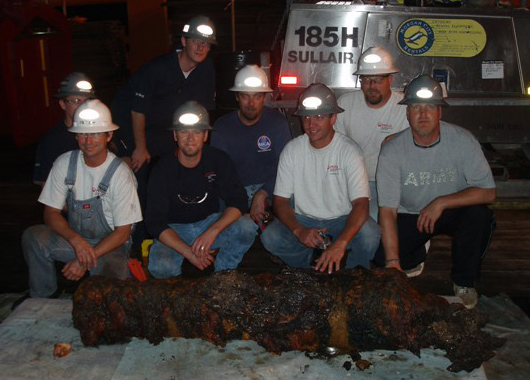 Last night the first big artifact was retrieved from the shipwreck site. The cannon, lodged against the starboard side of the shipwreck, was rigged with slings, lifted from the bottom, and hauled to the deck of Toisa Vigilant. The cannon was concreted to the seafloor from 200 years of immersion in salt water but came loose without too much trouble. A thick crust of concretion product, caused by the metal corroding and breaking down, encases the cannon. This will be cleaned off in the lab and we’ll see how much of the original metal is left. Iron artifacts require long periods of conservation and continual maintenance to preserve them and, in fact, archaeologists often decide to leave large iron objects like cannons and anchors in place on shipwreck sites.
Last night the first big artifact was retrieved from the shipwreck site. The cannon, lodged against the starboard side of the shipwreck, was rigged with slings, lifted from the bottom, and hauled to the deck of Toisa Vigilant. The cannon was concreted to the seafloor from 200 years of immersion in salt water but came loose without too much trouble. A thick crust of concretion product, caused by the metal corroding and breaking down, encases the cannon. This will be cleaned off in the lab and we’ll see how much of the original metal is left. Iron artifacts require long periods of conservation and continual maintenance to preserve them and, in fact, archaeologists often decide to leave large iron objects like cannons and anchors in place on shipwreck sites.
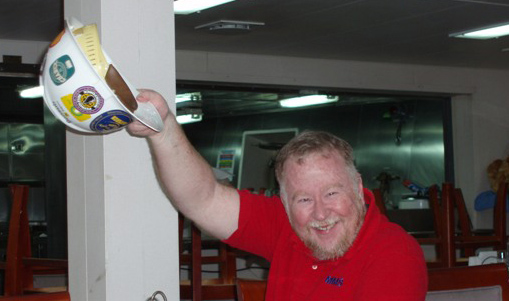 The Mardi Gras Shipwreck cannon was safely brought on-deck by the combined efforts of the ROV pilots, winch and crane operators, and deck crew. The cannon currently is wrapped in layers of foam padding, fabric, and plastic which will protect it on its journey to Texas A&M while keeping it wet so it doesn’t begin to deteriorate. The successful recovery of the cannon made MMS senior archaeologist Dr. Jack Irion very happy.
The Mardi Gras Shipwreck cannon was safely brought on-deck by the combined efforts of the ROV pilots, winch and crane operators, and deck crew. The cannon currently is wrapped in layers of foam padding, fabric, and plastic which will protect it on its journey to Texas A&M while keeping it wet so it doesn’t begin to deteriorate. The successful recovery of the cannon made MMS senior archaeologist Dr. Jack Irion very happy.
02 June 2007
Update by Della Scott-Ireton, FPAN, and Chris Horrell, MMS
Last night the ship’s stove, which may be a rare Brodie stove, was placed in a cargo net ready to be lifted to the surface. Although seemingly sturdy, it actually is very fragile and several of the panels separated during the move. The entire stove in its net was placed in the large red lifting basket and will be brought up as soon as the seas are very calm.
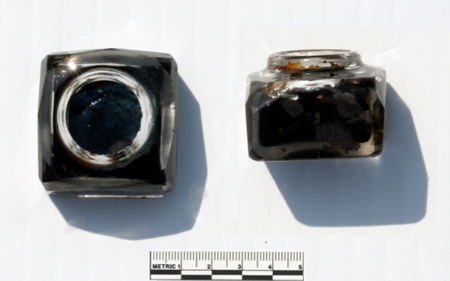 In addition to large artifacts like the cannon and stove, we continue to recover small artifacts which likely will provide us with more information about the shipwreck than will the big items. A small glass inkwell was recovered from the stern area; the black substance inside likely is sulfide from the chemical reaction of the glass to seawater. A delicate ceramic shaker was found in the stern as well. Made of creamware like the rest of the ceramics we’ve found, it probably was used for salt or other spice. As the small artifacts are brought on-board Toisa Vigilant, they are tagged with individual artifact numbers and immediately wrapped in padding material such as foam rubber and towels, then are placed in plastic containers. All of the small artifacts are being kept immersed in fresh water to prevent their drying out and cracking after their long soak in seawater. They will remain wrapped and wet during transport to Texas A&M’s conservation lab, where the long process of removing dissolved salts and stabilization will begin.
In addition to large artifacts like the cannon and stove, we continue to recover small artifacts which likely will provide us with more information about the shipwreck than will the big items. A small glass inkwell was recovered from the stern area; the black substance inside likely is sulfide from the chemical reaction of the glass to seawater. A delicate ceramic shaker was found in the stern as well. Made of creamware like the rest of the ceramics we’ve found, it probably was used for salt or other spice. As the small artifacts are brought on-board Toisa Vigilant, they are tagged with individual artifact numbers and immediately wrapped in padding material such as foam rubber and towels, then are placed in plastic containers. All of the small artifacts are being kept immersed in fresh water to prevent their drying out and cracking after their long soak in seawater. They will remain wrapped and wet during transport to Texas A&M’s conservation lab, where the long process of removing dissolved salts and stabilization will begin.
03 June 2007
Update by Chris Horrell, MMS and Ashley Gould Texas A&M University
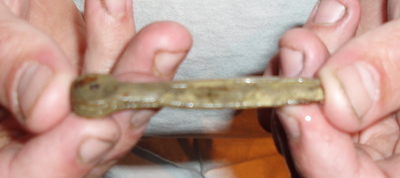 This morning, the seas calmed enough to raise the stove to the deck of Toisa Vigilant. While the stove is extremely fragile, it made the long journey to the surface where it was examined by the conservators and determined to be in good condition. The stove is in several pieces, a result of sitting on the seafloor for approximately 200 years and failure of its original bolts. The stove will undergo a long conservation process at Texas A&M University after which it will be reconstructed and made available for public viewing at the Louisiana State Museum.
This morning, the seas calmed enough to raise the stove to the deck of Toisa Vigilant. While the stove is extremely fragile, it made the long journey to the surface where it was examined by the conservators and determined to be in good condition. The stove is in several pieces, a result of sitting on the seafloor for approximately 200 years and failure of its original bolts. The stove will undergo a long conservation process at Texas A&M University after which it will be reconstructed and made available for public viewing at the Louisiana State Museum.
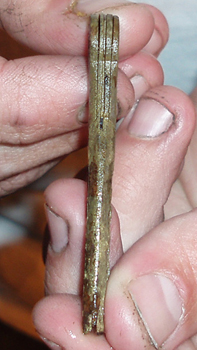 Other artifacts recovered today include the heel of a leather shoe, a spoon, and a pair of navigational dividers. One of the most interesting artifacts examined today was the ship itself. In order to examine the ship’s structure the four inch dredge attached to the ROV was lowered to the seafloor to remove the thin layer of sediment masking the ship timbers. Next to the gun box, archaeologists examined the visible structure and found some articulated timbers providing clues as to how the vessel was constructed. Archaeologists hope that this information will help them identify the type of ship and its function as it plied the waters of the Gulf of Mexico.
Other artifacts recovered today include the heel of a leather shoe, a spoon, and a pair of navigational dividers. One of the most interesting artifacts examined today was the ship itself. In order to examine the ship’s structure the four inch dredge attached to the ROV was lowered to the seafloor to remove the thin layer of sediment masking the ship timbers. Next to the gun box, archaeologists examined the visible structure and found some articulated timbers providing clues as to how the vessel was constructed. Archaeologists hope that this information will help them identify the type of ship and its function as it plied the waters of the Gulf of Mexico.
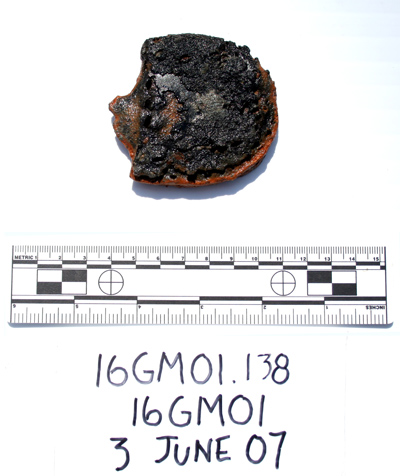
04 June 2007
By Dave Ball, MMS, and Alexis Catsambis, TAMU
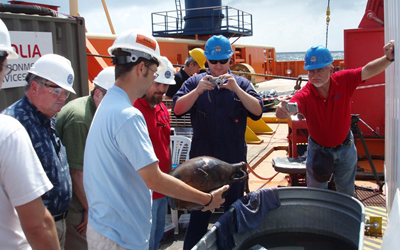 We began today by shooting another mosaic of the site in order to map the progress of the excavation thus far. Having brought up most of the artifacts on the site, the project is nearing completion. Yesterday the concretion at the stern of the vessel was recovered, along with a round timber, most likely a boom or spar from the rigging. Backfilling of the site will begin shortly.
We began today by shooting another mosaic of the site in order to map the progress of the excavation thus far. Having brought up most of the artifacts on the site, the project is nearing completion. Yesterday the concretion at the stern of the vessel was recovered, along with a round timber, most likely a boom or spar from the rigging. Backfilling of the site will begin shortly.
Today we also had a visit from four members of the Minerals Management Service. Steve Desauer, Dennis Chew, Joe Christopher, and Dr. Jim Kendall (Acting Deputy Director) flew out to witness first hand the progress that has been made on site. They were fascinated at the range of artifacts that have been recovered and the unique tools that have been modified to assist in the data recovery efforts.
05 June 2007
By Dave Ball, MMS, and Ben Ford, TAMU
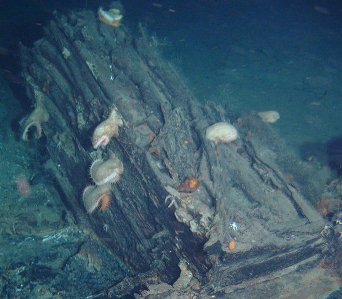 The final artifacts were excavated from the site today as additional sections of the hull were exposed in order to collect information on the vessel’s construction. Photo-mosaic surveys have been collected throughout the excavation process in order to accurately document the site. Once the final artifacts are retrieved, the clean up and backfilling process will begin.
The final artifacts were excavated from the site today as additional sections of the hull were exposed in order to collect information on the vessel’s construction. Photo-mosaic surveys have been collected throughout the excavation process in order to accurately document the site. Once the final artifacts are retrieved, the clean up and backfilling process will begin.
We have already removed most of the tools that have been used to conduct this excavation at 4,000 feet below the water’s surface, and will soon cover over all of the exposed hull remains in order to preserve the integrity of the wood. If we remain on our current schedule, we should be returning to dock some time tomorrow afternoon.
06 June 2007
Chris Horrell, MMS, and Dave Ball, MMS.
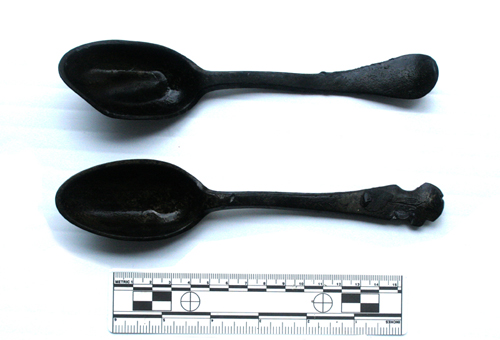 As the Mardi Gras Shipwreck team prepared for the backfilling of the site to begin, a few final artifacts were recovered. These artifacts included two pewter spoons and two buttons. In addition, a brass butt plate from one of the muskets was also recovered. All of these artifacts had maker’s marks or hallmarks on them providing clues as to the age of the ship. These hallmarks will be researched once the team comes back from the field and the conservation process begins.
As the Mardi Gras Shipwreck team prepared for the backfilling of the site to begin, a few final artifacts were recovered. These artifacts included two pewter spoons and two buttons. In addition, a brass butt plate from one of the muskets was also recovered. All of these artifacts had maker’s marks or hallmarks on them providing clues as to the age of the ship. These hallmarks will be researched once the team comes back from the field and the conservation process begins.
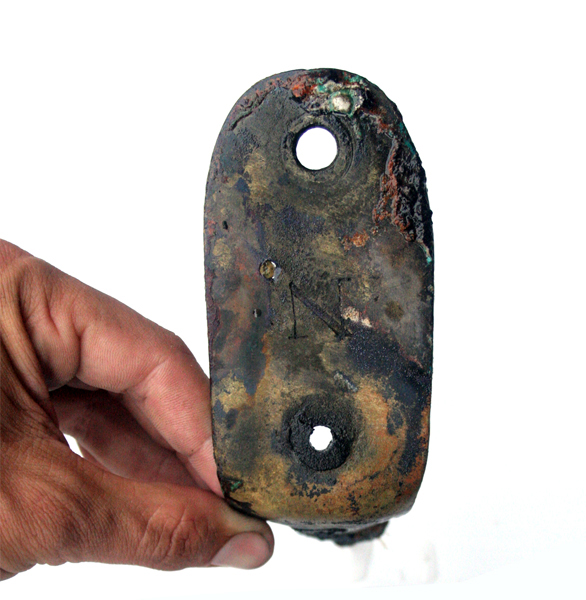 The long process of backfilling the site also began today as the project started to wind down. Backfilling an archaeological site is important as it provides protection for areas that were exposed during excavation. These exposed areas would normally decay if left open to the natural environment so it is important that we cover up these areas. Since this fieldwork effort focused primarily on recovering diagnostic artifacts that could provide answers to the vessel’s age and nationality, there is still important information on the construction of the ship’s hull that can be obtained through future field investigations. Once backfilling is complete, our vessel, Toisa Vigilant, will begin the long journey back to Port Fourchon, Louisiana.
The long process of backfilling the site also began today as the project started to wind down. Backfilling an archaeological site is important as it provides protection for areas that were exposed during excavation. These exposed areas would normally decay if left open to the natural environment so it is important that we cover up these areas. Since this fieldwork effort focused primarily on recovering diagnostic artifacts that could provide answers to the vessel’s age and nationality, there is still important information on the construction of the ship’s hull that can be obtained through future field investigations. Once backfilling is complete, our vessel, Toisa Vigilant, will begin the long journey back to Port Fourchon, Louisiana.
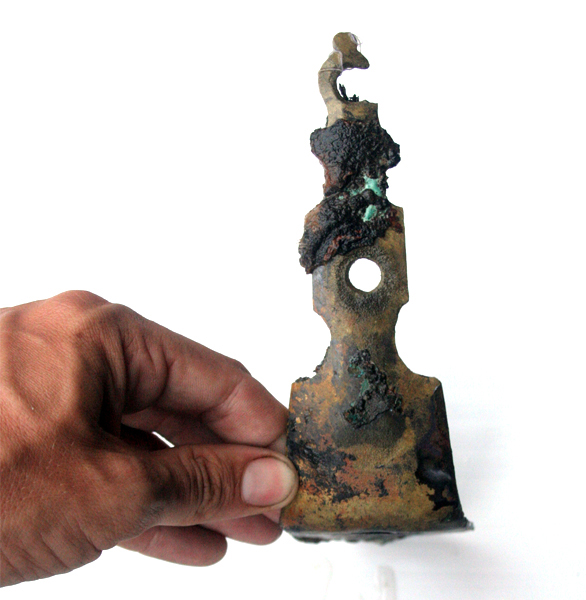
07 June 2007
Chris Horrell, MMS, and Dave Ball, MMS
 Toisa Vigilant arrived back at Port Fourchon, Louisiana around 2:30 this morning concluding the field work component of our project. This has been an exciting and wonderful archaeological investigation of an important period of Gulf of Mexico history. However, the project does not end here! Conservation of the artifacts may take up to a year and once they complete this process, they will be transported back to Louisiana where they will go on display at the Louisiana State Museum. In addition, a final report will be made detailing the methodology, artifacts, and conservation of the project. All of these components will help archaeologists, historians, and the people of the Gulf Coast better understand their maritime history.
Toisa Vigilant arrived back at Port Fourchon, Louisiana around 2:30 this morning concluding the field work component of our project. This has been an exciting and wonderful archaeological investigation of an important period of Gulf of Mexico history. However, the project does not end here! Conservation of the artifacts may take up to a year and once they complete this process, they will be transported back to Louisiana where they will go on display at the Louisiana State Museum. In addition, a final report will be made detailing the methodology, artifacts, and conservation of the project. All of these components will help archaeologists, historians, and the people of the Gulf Coast better understand their maritime history.
